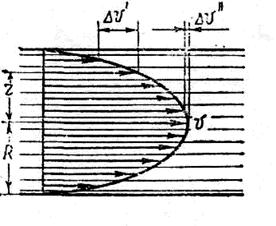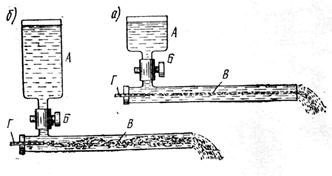 |
АвтоАвтоматизацияАрхитектураАстрономияАудитБиологияБухгалтерияВоенное делоГенетикаГеографияГеологияГосударствоДомДругоеЖурналистика и СМИИзобретательствоИностранные языкиИнформатикаИскусствоИсторияКомпьютерыКулинарияКультураЛексикологияЛитератураЛогикаМаркетингМатематикаМашиностроениеМедицинаМенеджментМеталлы и СваркаМеханикаМузыкаНаселениеОбразованиеОхрана безопасности жизниОхрана ТрудаПедагогикаПолитикаПравоПриборостроениеПрограммированиеПроизводствоПромышленностьПсихологияРадиоРегилияСвязьСоциологияСпортСтандартизацияСтроительствоТехнологииТорговляТуризмФизикаФизиологияФилософияФинансыХимияХозяйствоЦеннообразованиеЧерчениеЭкологияЭконометрикаЭкономикаЭлектроникаЮриспунденкция
Current of a liquid on a horizontal pipe. Puazal’s law
 Let's consider current of a viscous, moistening wall of a liquid on a horizontal pipe of constant section therefore, it is important for understanding of process of movement of blood on vessels. At rather low speed current thus has laminar character: the layer of molecules, adjoining to a wall of a pipe, sticks to it and remains motionless. Following layers of molecules under action of force of pressure and at counteraction of force of internal friction between layers it is displaced rather a previous layer and moves in relation to walls of a pipe with some small speed. Each subsequent layer of molecules, mixing up concerning the previous layer, moves in relation to a wall of a pipe with gradually increasing speed which reaches the greatest value in the center of a pipe.
Let's consider current of a viscous, moistening wall of a liquid on a horizontal pipe of constant section therefore, it is important for understanding of process of movement of blood on vessels. At rather low speed current thus has laminar character: the layer of molecules, adjoining to a wall of a pipe, sticks to it and remains motionless. Following layers of molecules under action of force of pressure and at counteraction of force of internal friction between layers it is displaced rather a previous layer and moves in relation to walls of a pipe with some small speed. Each subsequent layer of molecules, mixing up concerning the previous layer, moves in relation to a wall of a pipe with gradually increasing speed which reaches the greatest value in the center of a pipe.
The mathematical analysis of this phenomenon shows, that distribution of speeds on section of a round pipe has parabolic character

The maximal speed in the center of a pipe
 .
.
In these formulas:  — pressure in the beginning and in the end of a site of a pipe in length
— pressure in the beginning and in the end of a site of a pipe in length  - factor of viscosity of a liquid, R - radius of a pipe and r - radius of a considered layer of liquids. Gradient of speed, on absolute size equal
- factor of viscosity of a liquid, R - radius of a pipe and r - radius of a considered layer of liquids. Gradient of speed, on absolute size equal
 , gradually decreases and addresses in a zero on an axis of a pipe.
, gradually decreases and addresses in a zero on an axis of a pipe.
 Laminar current is established in pipes with smooth walls, without sharp changes of the area of section or bends of a pipe, and as at absence of plural branching. At infringement of these conditions and especially at high speeds current passes in turbulent: speeds of particles of a liquid thus vary randomly, formed local turbulences - there is a mixing of particles of a liquid.
Laminar current is established in pipes with smooth walls, without sharp changes of the area of section or bends of a pipe, and as at absence of plural branching. At infringement of these conditions and especially at high speeds current passes in turbulent: speeds of particles of a liquid thus vary randomly, formed local turbulences - there is a mixing of particles of a liquid.
For turbulent current local changes of pressure in the liquids causing oscillatory movement of particles, accompanied the sound phenomena (noise, murmur, etc.) owing to which turbulent current is easily found out are characteristic. Turbulent current is connected with additional expenses of energy at movement of a liquid, therefore in blood system it can lead to additional loading on heart. Noise arising at turbulent current of blood, can be used for diagnostics of diseases. At defeat of valves of heart there are the so-called intimate noise caused by turbulent current of blood. Turbulent current of blood in an aorta can be caused, first of all, by turbulence of a blood-groove in an input in it: whirlwinds of a stream exist, when blood is pushed out from ventricle in an aorta. At places of a branching of vessels, and also at increase of speed of a blood-groove current can become turbulent in arteries. Turbulent current can arise in a vessel in the field of its local narrowing, for example, at formation of a blood thrombus.
Speed  (critical speed) of transition of laminar current in turbulent it is possible to define, using the criterion certain from experience - Reynolds's Re number (dimensionless size) which connects it with density
(critical speed) of transition of laminar current in turbulent it is possible to define, using the criterion certain from experience - Reynolds's Re number (dimensionless size) which connects it with density  , viscosity of a liquid
, viscosity of a liquid  and diameter D of a pipe:
and diameter D of a pipe:  .
.
If Re ≤ 1000, then the current is laminar, if Re > 1000, that current is turbulent. Current of blood on vessels depends upon its viscosity. Current of blood can be laminar or turbulent. Laminar current of blood creates smaller loading on heart as at it work of heart is directly proportional to volumetric speed of a blood-groove, at turbulent movement of blood between these parameters almost square-law dependence is established (А~ Q1,8).
At current of a real liquid on a horizontal pipe potential energy of its particles is spent for work on overcoming internal friction and consequently static pressure along a pipe gradually falls. To provide current of a liquid, it is necessary to create the pressure a little bit exceeding pressure drops along all pipe in the beginning of a pipe. In a pipe of constant section pressure falls in regular intervals. If to connect levels of a liquid in the manometrical tubes established along a pipe, the direct line will turn out. (fig). If it to continue up to the basic vessel A it will divide height h a column of a liquid in a vessel on two parts h1 and h2.
The height h1 corresponds to initial static pressure  , height h2 - to dynamic pressure
, height h2 - to dynamic pressure  causing speed of current of a liquid. The tangent of a corner of an inclination of this straight line characterizes a gradient of pressure (pressure drop on unit of length of pipe):
causing speed of current of a liquid. The tangent of a corner of an inclination of this straight line characterizes a gradient of pressure (pressure drop on unit of length of pipe):  .
.
 Puazal has established, that average speed
Puazal has established, that average speed  of laminar current of a liquid on to rather narrow horizontal round pipe of constant section it is directly proportional to a difference of pressure
of laminar current of a liquid on to rather narrow horizontal round pipe of constant section it is directly proportional to a difference of pressure  at an input and an output from a pipe, to a square of radius R of a pipe and inversely proportional to length l pipes and to factor of viscosity
at an input and an output from a pipe, to a square of radius R of a pipe and inversely proportional to length l pipes and to factor of viscosity  of liquid (law Puazal);
of liquid (law Puazal);

Average speed  of current of a liquid defines the quantity of liquid Q proceeding through cross-section section S of a pipe in unit of time:
of current of a liquid defines the quantity of liquid Q proceeding through cross-section section S of a pipe in unit of time:  Hence,
Hence,

This formula also name usually formula Gagen - Puazal. It can give and such kind:
 , where
, where 
Value ω is called hydraulic resistance.
Поиск по сайту: